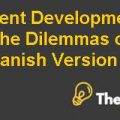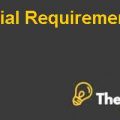
Portfolio Management Case Solution
Please enter your answers in this file after each question. Please do the required analysis on the excel spreadsheet. Support your written analysis with tables that you cut and paste from the excel file into this file.
When you finish, please email the word file and the excel file to me and copy my secretary. Simply give a “reply to all” to my email. Save your files with your student ID number only. Please don’t place your name on the exam.
Some parts are more challenging than others. If you have trouble with one part just move on.
If you prefer to answer in Spanish it is not a problem, but do keep the technical terms in English.
Asset Allocation.
Worksheet ASSET ALL OCATION DATA shows the log returns for investment grade bonds (Barclays Global Aggregate) and three categories of equity: US, EAFE-Canada and Emerging Markets.
a. Find the historical correlation between these assets and the variance covariance matrix.
The historical correlation and the variance covariance matrix are shown below:
ρ Global Agg US EAFE-Canada Emerging Markets
Global Agg 1.00 (0.00) 0.07 0.08
US (0.00) 1.00 0.90 0.79
EAFE-Canada 0.07 0.90 1.00 0.90
Emerging Markets 0.08 0.79 0.90 1.00
∑ Bar Gl Agg MSCI US MSCI EAFE MSCI EM
Global Agg 0.000060 (0.000000) 0.000026 0.000043
US (0.000000) 0.001731 0.001928 0.002223
EAFE-Canada 0.000026 0.001928 0.002660 0.003143
Emerging Markets 0.000043 0.002223 0.003143 0.004576
b. Perform the following calculations for an equal weighted portfolio of the four assets:
i. The μw and σw.
The mean and the standard deviation of the portfolio are 0.5% and 2.9%.
ii. The probability of loss in one year.
The probability of loss in 1 year is 43%
iii. The probability of loss in three years. Comment on the difference with ii.
The probability of loss in three years is 57%. As the duration of holding the portfolio increases, the probability of incurring a loss also increases.
iv. One year 1% value at risk (VAR). What does VAR mean?
Value at risk is basically the maximum amount or percentage of the value of an asset which the investor is expected to lose. The VAR for 1 year for 1% is:
Portfolio Value 100
Avg Return 0.5%
Stdev 2.9%
Confidence Level 0.99
Min return with 99% prob -0.062742145
Vakue of portfolio 93.7257855
VAR 6.27%
v. One year 5% value at risk (VAR). Comment on the difference with iv.
The value at risk for one year 5% confidence level is:
Portfolio Value 100
Avg Return 0.5%
Stdev 2.9%
Confidence Level 0.95
Min return with 95% prob -0.042868928
Vakue of portfolio 95.71310723
VAR 4.29%
The probability is decreased which means that the chances of loss on the portfolio are higher in the first year whereas it reduces with each year, hence the portfolio becomes more strong.
vi. Average and median wealth after 5 years. Explain why the average and median are different.
Assuming an initial wealth of $100 million, the average and median wealth after 5 years would be as follows:
Year 1 2 3 4 5
Wealth 95.71 91.61 87.68 83.92 80.33
Average Wealth 87.851
Median Wealth 87.683
The median and average are slightly different because the average takes into account all the values over the five year period whereas this is not the case in median calculation.
c. Find the following long only portfolios
i. The portfolio that minimizes the volatility for a return of 5.6%
This would be:
Minimum volatility for return of 5.6% 60% 10% 15% 15%
ii. The portfolio that minimizes volatility for a return of 7.0%. Comment on the difference with i.
Minum volatility for return of 7.0% 40% 40% 10% 10%
iii. The portfolio that minimizes the volatility
Minimum volatility 40.00% 20.00% 40.00% 0.00%.....................
This is just a sample partial case solution. Please place the order on the website to order your own originally done case solution.













